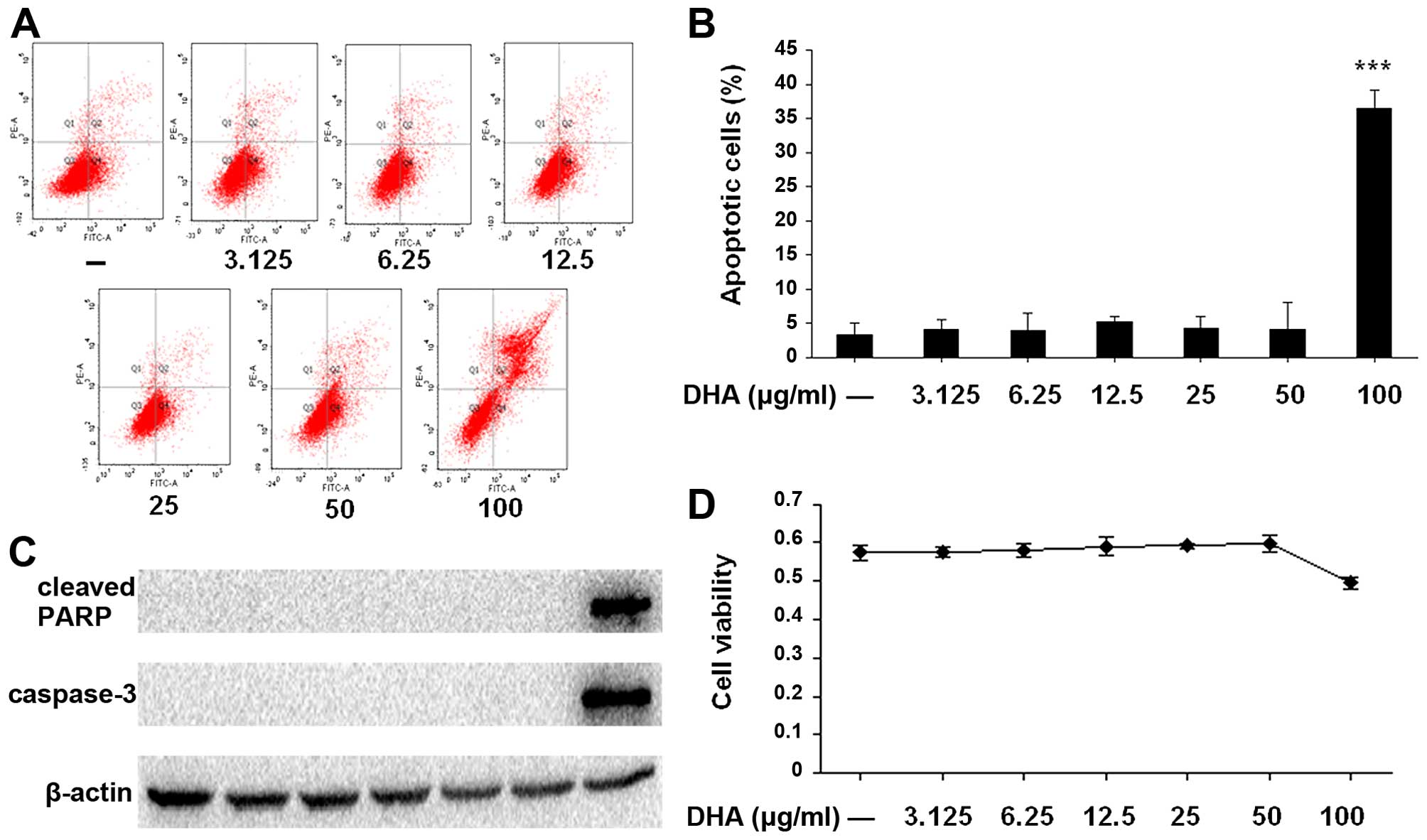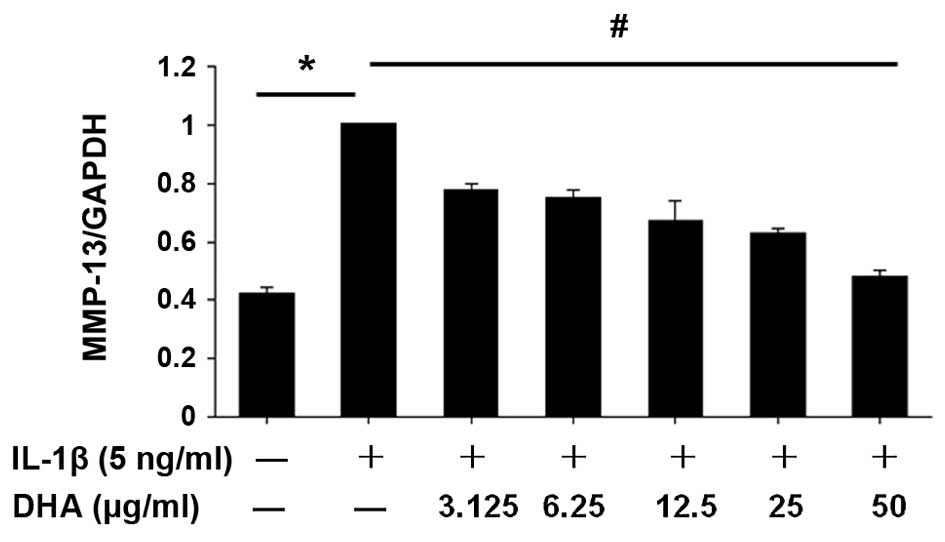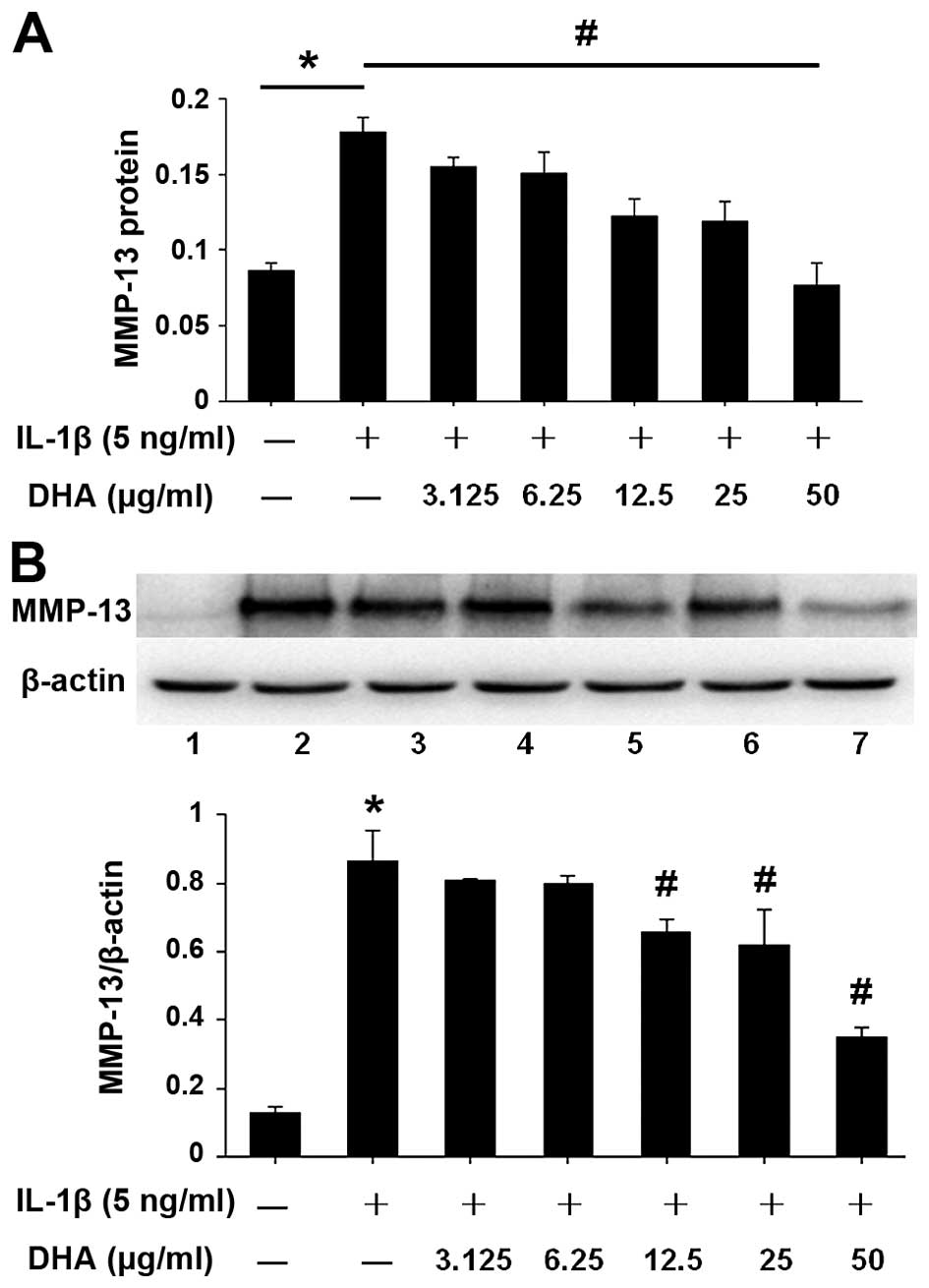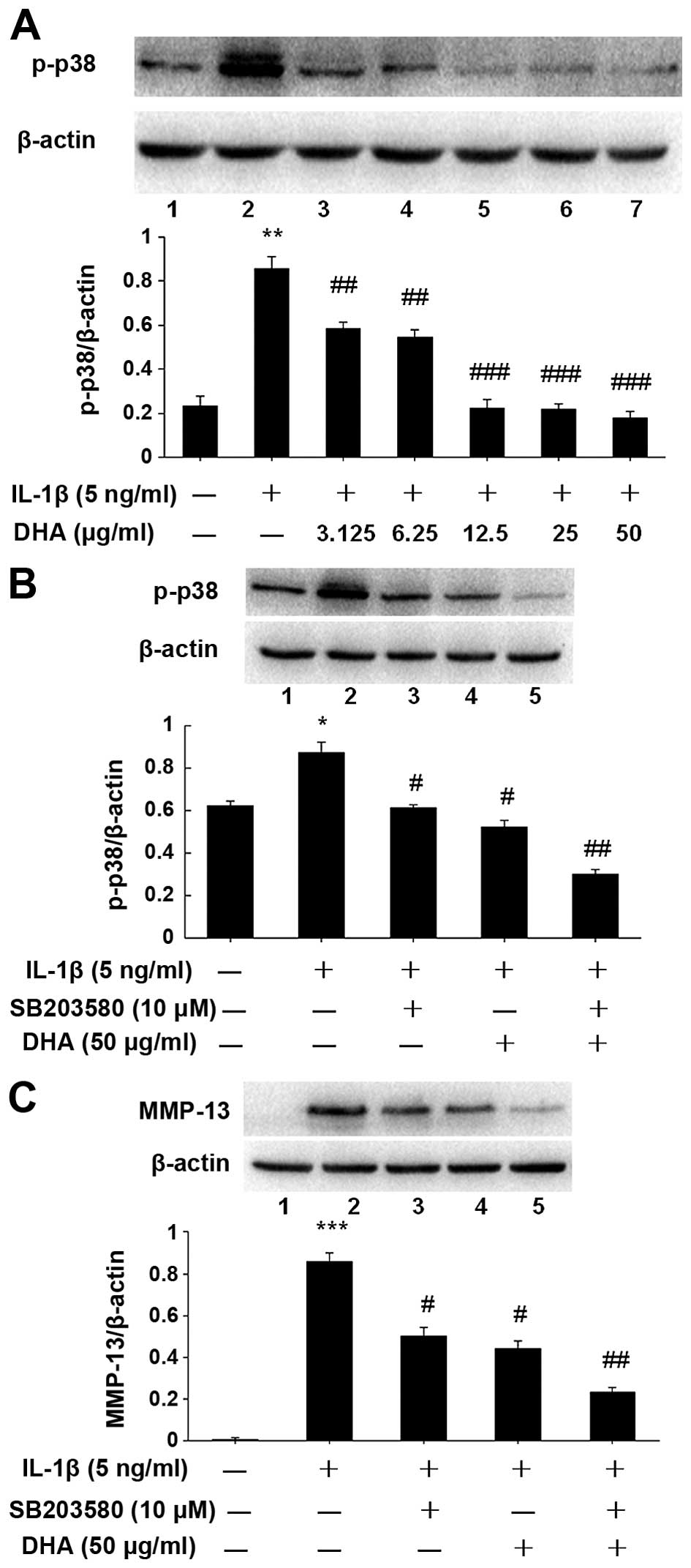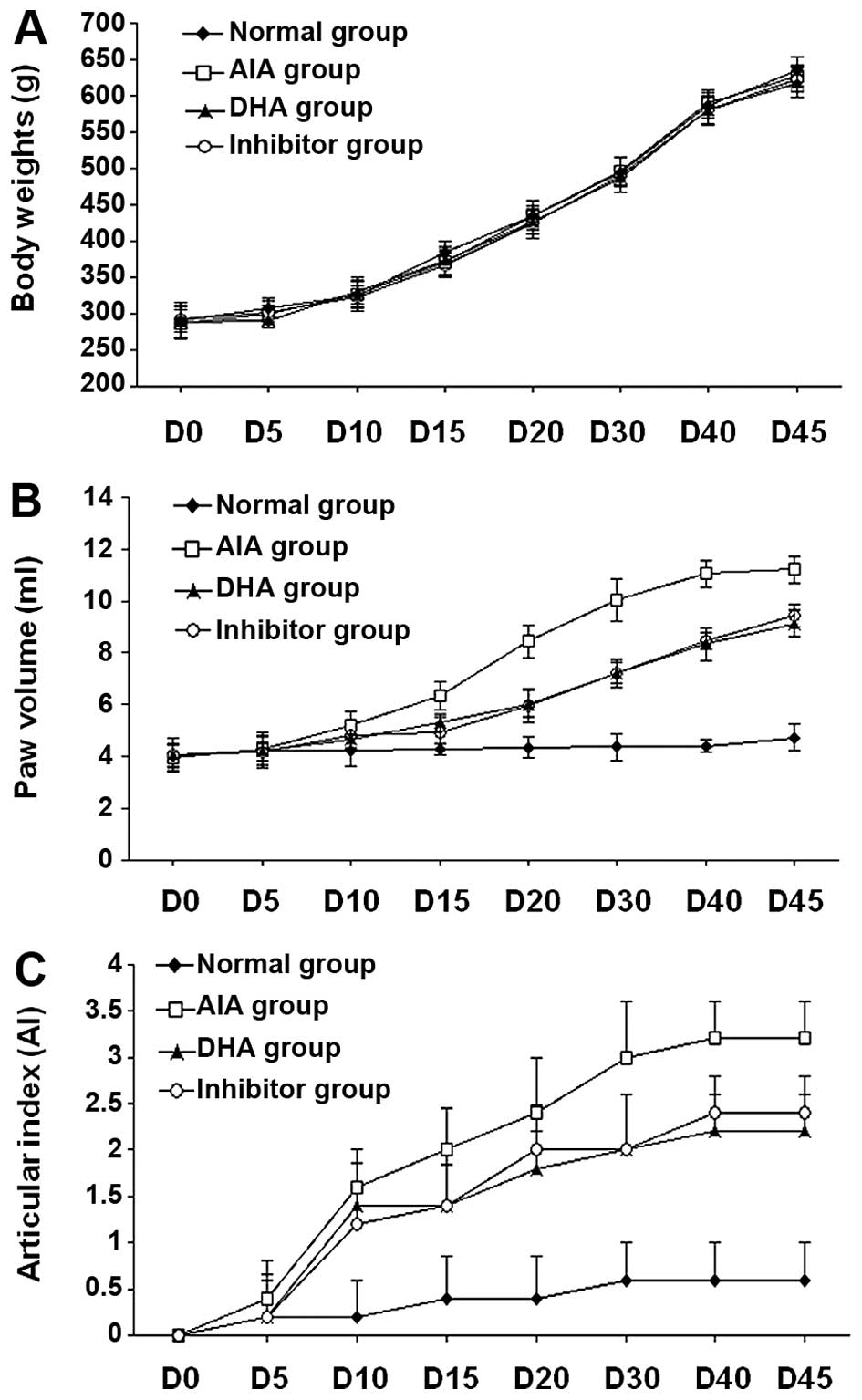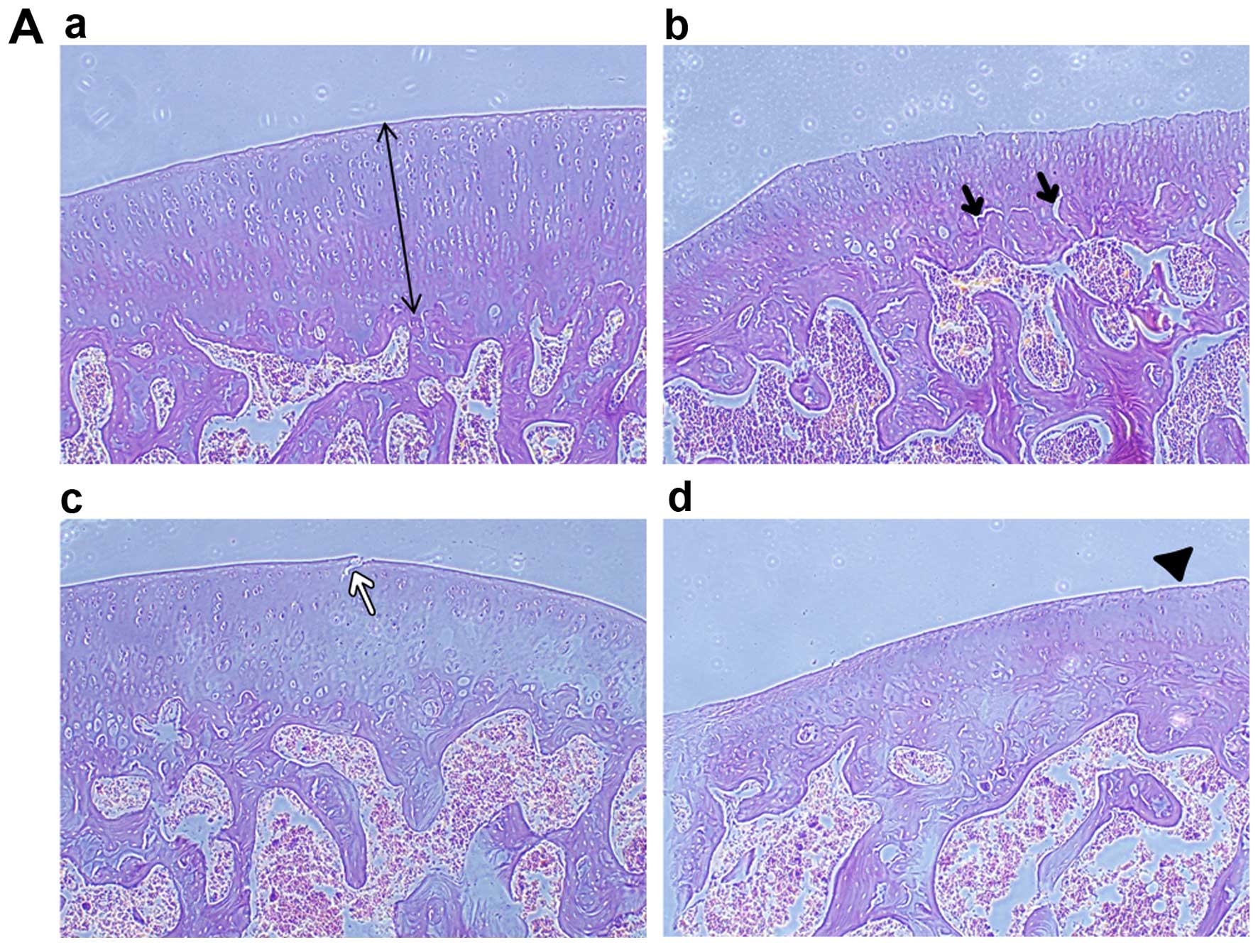Docosahexenoic acid treatment ameliorates cartilage degeneration via a p38 MAPK-dependent mechanism
- Authors:
- Published online on: April 14, 2016 https://doi.org/10.3892/ijmm.2016.2567
- Pages: 1542-1550
-
Copyright: © Wang et al. This is an open access article distributed under the terms of Creative Commons Attribution License.
Abstract
Introduction
Osteoarthritis (OA) is the most common type of arthritis in adults throughout the world, and is characterized by the progressive degeneration of articular cartilage including chondrocyte loss and degradation of the extracellular matrix (ECM) (1,2). Although the etiology and pathology of OA is not completely elucidated, the degradation and destruction of type II collagen caused by matrix metalloproteinase-13 (MMP-13) is considered the central feature in the occurrence and development of OA (3,4). MMP-13 is therefore a target for therapeutic intervention that potentially reduces the development and progression of OA.
Pro-inflammatory cytokines secreted by chondrocytes contribute to the progression of OA, of which interleukin-1β (IL-1β) plays a key role in the pathogenesis of OA by suppressing the synthesis of type II collagen and aggrecan, the important constituents of cartilage matrix (5–7). Furthermore, in the development of OA, IL-1β upregulated MMP-mediated cartilage degradation by activating a diverse spectrum of signaling cascades in human chondrocytes or inhibiting the expression of the tissue inhibitor of MMPs in arthritic joints (3,8,9). It has been reported that the gene expression profiles, especially MMP expression in response to IL-1β treatment, are similar between the human SW1353 chondrosarcoma cell line and primary human adult articular chondrocytes (10–12).
Previous studies demonstrated the potent anti-inflammatory property of ω-3 polyunsaturated fatty acids (n-3 PUFAs) in chronic inflammatory disorders, such as periodontal disease (PD) and inflammatory bowel disease (IBD) (13–15). Docosahexenoic acid (DHA), a long-chain n-3 PUFA, has been used to treat different types of inflammatory diseases. Recent studies have shown that treatment with n-3 PUFAs, especially DHA, can decrease the levels of pro-inflammatory markers, and increase the levels of anti-inflammatory markers, as well as improve outcomes in diseases, including rheumatoid arthritis (RA) and cardiovascular disease (16,17). Therefore, increasing the dietary level of DHA in patients with arthritis for attenuation of pain and inflammation in their joints is recommended (18). Additionally n-3 PUFAs, such as DHA and eicosapentaenoic acid (EPA), downregulate the transcription of various important proteins associated with the pathology of OA, including a disintegrin and metalloproteinase with thrombospondin motifs (ADAMTS) family, such as ADAMTS-4 and ADAMTS-5, and other genes including MMP-3, cyclooxygenase-2, IL-1α, IL-1β and tumor necrosis factor-α (TNF-α) (19). However, the underlying mechanism by which DHA reduces MMP-13 expression in OA remains to be elucidated.
The aim of the present study was to investigate the inhibitory effects of DHA on OA development, using IL-1β-stimulated SW1353 chondrosarcoma cells, and a rat adjuvant-induced arthritis (AIA) model, and examine the related mechanisms.
Materials and methods
Reagents and cell line
DHA and recombinant human IL-1β were purchased from Sigma-Aldrich (St. Louis, MO, USA). DHA was dissolved in dehydrated alcohol and then diluted to 100 µg/ml using Dulbecco's Modified Eagle's Medium (DMEM; Gibco Life Technologies, Carlsbad, CA, USA). Stock solutions of DHA (100 µg/ml) and IL-1β (100 ng/ml) in DMEM were stored at −20°C. Prior to treatment, the solutions were diluted to the required concentrations.
The human SW1353 chondrosarcoma cell line (Cell Applications, Inc., San Diego, CA, USA) was grown in monolayer at 37°C, in a humidified atmosphere under 5% CO2, with DMEM supplemented with 10% (v/v) FBS and 100 U/ml penicillin-streptomycin solution. Prior to the treatment, SW1353 cells were starved for 24 h with serum-free DMED medium (containing 100 U/ml penicillin-streptomycin), and then pretreated with various concentrations of DHA as required for 1 h, followed by the addition of IL-1β (5 ng/ml) to culture medium in the presence of DHA for another 24 h.
Flow cytometry
The number of apoptotic cells was determined by flow cytometric analysis. After DHA treatment for 24 h, the SW1353 cells were collected and resuspended at a density of 1×106 cells/ml in 1X binding buffer (Sigma, St. Louis, MO, USA). The cells were simultaneously stained with fluorescein isothiocyanate-annexin V and propidium iodide included in an Apoptosis Detection kit I (BD Biosciences, San Jose, CA, USA), and then examined by FACSAria™ II flow cytometer (BD Biosciences), according to the manufacturer's instructions.
MTT assay
The cytotoxicity of DHA (0–100 µg/ml) in SW1353 cells was evaluated using an MTT assay. SW1353 cells were cultured in 96-well plates at a density of 1×104 cells/well and treated with various concentrations of DHA for 24 h. At the endpoint of treatment, 3-(4,5-dimethylthiazol-2-yl)-2,5-diphe-nyltetrazolium bromide (MTT) reagent (Sigma) was added to each well at the final concentration of 5 mg/ml for another 4 h incubation. The supernatants in each well were removed, and insoluble formazan crystals were dissolved in dimethylsul-phoxide (Sigma). The absorbance of the colored solution was measured at 570 nm using an enzyme-labeled meter (Thermo Fisher Scientific, Waltham, MA, USA).
ELISA
SW1353 cells were pretreated with DHA (3.125, 6.25, 12.5, 25 and 50 µg/ml) as mentioned earlier. The level of MMP-13 protein in the culture supernatant, which was secreted from SW1353 cells, was determined by ELISA kits (Abcam, Cambridge, UK) according to the manufacturer's instructions.
Reverse transcription-quantitative polymerase chain reaction (RT-qPCR)
Total cellular RNA was extracted using TRIzol reagent (Dingguo Changsheng Biotechnology Co., Ltd., Beijing, China), according to the manufacturer's instructions. Purified RNA was dissolved in diethylpyrocarbonate-treated water, and stored at −80°C prior to use. The first-strand cDNA was synthesized using 1 µg of total RNA using the PrimeScript RT reagent kit (TianGen Biotech, Beijing, China). PCR amplification was carried out using specific primers as indicated in Table I, the SYBR Premix Ex Taq (Takara Biotechnology Co., Ltd., Dalian, China) and reagents of the StepOne Real-Time PCR System (Applied Biosystems, Foster City, CA, USA). Typical profiles for PCR were denaturation at 95°C for 30 sec, followed by annealing at 95°C for 15 sec and extension at 60°C for 32 sec for total 40 cycles. GAPDH was used as an endogenous control in PCR. The mRNA level of MMP-13 was normalized to that of GAPDH. The data from three independent experiments, were analyzed using the ΔΔCt method and compared with the control group.
Western blotting
Proteins were extracted from cells, using radio immunoprecipitation assay buffer plus 1% protease inhibitor cocktail (Roche Molecular Diagnostics, Pleasanton, CA, USA, USA). Specifically, phosphorylated proteins were extracted using a phosphorylated protein extraction kit (Roche Molecular Diagnostics). The protein samples were separated by 12% sodium dodecyl sulphate-polyacrylamide gel electrophoresis and transferred onto polyvinylidene fluoride membranes. The membranes were then blocked with 5% non-fat milk dissolved in 1% TBST buffer and probed with primary antibodies against MMP-13 (polyclonal antibody, 1:500; Santa Cruz Biotechnology, Inc., Dallas, TX, USA), p-p38 (monoclonal antibody, 1:1,000; Santa Cruz Biotechnology, Inc.), cleaved PARP (polyclonal antibody, 1:500; Santa Cruz Biotechnology, Inc.), caspase-3 (polyclonal antibody, 1:500; Santa Cruz Biotechnology, Inc.) and β-actin (monoclonal antibody 1:5,000; Santa Cruz Biotechnology, Inc.) on a shaker at 4°C overnight. After washing with 1% TBST, the blots were incubated with appropriate diluted horseradish peroxidase (HRP)-labeled secondary antibodies for 1 h at room temperature. Signals were visualized by using enhanced chemiluminescence (Beyotime Institute of Biotechnology, Shanghai, China). ChemiDoc XRS+ (Bio-Rad, Berkeley, CA, USA) was used to quantify the protein bands. Data from three independent experiments were calculated as the ratio of the gray values of MMP-13 protein/gray values of β-actin.
Animals and husbandry
Twenty adult male Sprague-Dawley (SD) rats (280–300 g, 8-week-old) were supplied by the Beijing Friendship Hospital Laboratory Animal Center. The rats were randomly divided into the normal control, AIA, DHA and inhibitor groups. The rats were kept in separate cages (5 rats per cage), at a temperature of 22–23°C and a relative humidity of 40–60%. The rats were allowed free access to distilled water and food and allowed to acclimatize for one day prior to use. Procedures were approved by the Animal Ethics Committee of Beijing Friendship Hospital, Capital Medical University.
Food preparation and administration of SD rats
The rats in the normal control and AIA groups were fed the AIN-93G diet, while those in the DHA group were fed the AIN-93G diet containing DHA (50 g/kg) (20) and the inhibitor group on the AIN-93G diet containing SB203580 (10 mg/kg). Food was supplied by the China-Japan Food Research Center, China Agricultural University. Complete Freund's adjuvant (CFA) was purchased from Sigma-Aldrich and dissolved in sterile paraffin oil (5 mg/ml). The normal control group received an injection of 0.3 ml of paraffin oil in the left hind paw, while other groups received a subcutaneous injection of 0.3 ml of CFA to induce experimental AIA, at day 0.
Assessment of clinical parameters in experimental animals
The clinical parameters were assessed, including body weight, paw volume, and articular index (AI) score (range 0–4; 0 for no swelling or erythema, 1 for slight swelling and/or erythema, 2 for low-to-moderate edema, 3 for pronounced edema with limited use of the joint, and 4 for excessive edema with joint rigidity) (21). AI scores were recorded for each knee joint by the same observer, who was blinded to the treatment in the 4 groups. Paw volume was measured by a plethysmometer (MK-101P; NatureGene Corp., Beijing, China). Parameters were recorded on days 0, 5, 10, 15, 20, 30, 40 and 45.
Histological examination and immunohistochemistry (IHC)
At day 45th, the rats were sacrificed to collect their hind knee joints. Portions of the joints were fixed in 10% neutral-buffered formalin. After 5 days of fixation, the sections were decalcified using a decalcifying solution, containing 24.4% formic acid, and 0.5 N sodium hydroxide for 5 days, in which decalcifying solution was changed daily. The median joint parts were then longitudinally trimmed and embedded in paraffin, sectioned (4 µm), and stained with hematoxylin and eosin (H&E) and Safranin-Orange-fast green (Safranin-O). Histological features of specimens were graded using a modified Mankin's score (22). For IHC, the sections were incubated with primary antibody against MMP-13 (polyclonal, 1:50), and secondary biotinylated goat anti-rabbit immunoglobulin G (IgG). The positive signals were visualized with HRP/avidin-biotin complex, using 3,3′-diaminobenzidine tetrahydrochloride as the chromogen (Dako, Carpinteria, CA, USA). Negative control in IHC was made by incubating with an isotype of IgG. MMP-13-positive chondrocytes were determined by counting the number of positive cells in IHC and then dividing this number by the total number of chondrocytes visualized by hematoxylin counterstaining.
Statistical analysis
Data from three independent experiments were presented as the mean ± standard errors of means. Statistical significance of the results among each group was determined using one-way analysis of variance. P<0.05 was considered to indicate a statistically significant difference. Statistical analysis was performed using SPSS 17.0 software (SPSS, Inc., Chicago, IL, USA).
Results
Safe concentration range of DHA in treatment of SW1353 cells is 0–50 µg/ml in vitro
The cytotoxicity of DHA in the treatment of SW1353 cells at different concentration of DHA (3.125, 6.25, 12.5, 25, 50 and 100 µg/ml) was assessed by flow cytometry and MTT assay. As shown in Fig. 1, when SW1353 cells were treated with DHA at a dose of 100 µg/ml, cell viability significantly decreased and the number of apoptotic cells was higher, as compared to other doses ranging from 3.125 to 50 µg/ml, in which DHA did not present cytotoxic effects. Western blot analysis also showed that the levels of cleaved PARP and caspase-3 were markedly increased with the dose of 100 µg/ml DHA. Thus, 0–50 µg/ml of DHA was used in the subsequent experiments.
DHA suppresses the mRNA expression of MMP-13 in IL-1β-stimulated SW1353 cells
SW1353 cells were treated with a series of concentrations of DHA (0, 3.125, 6.25, 12.5, 25 and 50 µg/ml) for 1 h, followed by stimulation of IL-1β (5 ng/ml) i.e., co-incubation with IL-1β and DHA for 24 h. Total RNA was then isolated from the harvested cells. The mRNA expression level of MMP-13 in DHA-treated cells was measured by RT-qPCR. As shown in Fig. 2, IL-1β-enhanced MMP-13 expression in SW1353 cells was inhibited by DHA in a dose-dependent manner.
DHA inhibits MMP-13 protein expression in IL-1β-stimulated SW1353 cells
To evaluate the inhibitory effect of DHA on MMP-13 protein expression, DHA pretreatment and co-incubation with IL-1β were performed in SW1353 cells, under the same conditions as those for Fig. 2. Following treatment, protein was extracted from cell pellets and MMP-13 expression was analyzed by western blotting (Fig. 3B). The level of MMP-13 in the supernatant was also measured, using the ELISA kit (Fig. 3A). The results showed that the expression level of MMP-13 protein in each group was consistent with the mRNA expression level detected by PCR. DHA treatment reduced the protein expression of MMP-13 in IL-1β-stimulated SW1353 cells. DHA-mediated inhibition was dose-dependent and 50 µg/ml DHA showed the strongest inhibitory effect (Fig. 3).
Inhibitory effect of DHA on MMP-13 expression via a p38 mitogen-activated protein kinase (MAPK)-dependent mechanism
Previous findings showed that the MAPK signaling pathway was involved in cartilage proliferation, apoptosis and differentiation (23). IL-1 induced activation of the key enzymes in the MAPK signaling pathway, such as p38, c-Jun N-terminal kinase (JNK) and extracellular signal-regulated kinase (ERK) (23–25). IL-1 also upregulated MMP expression to promote the degradation of articular cartilage. To identify the signaling pathway and related enzyme(s) involved in the inhibitory effects of DHA, SW1353 cells were pretreated with DHA at different concentrations (0, 3.125, 6.25, 12.5, 25 and 50 µg/ml) for 1 h, and then stimulated with IL-1β (5 ng/ml) for 24 h. The level of p-p38 in the treated cells was examined by western blotting. As shown in Fig. 4A, the p-p38 level was decreased by DHA treatment in a dose-dependent manner. Furthermore, SW1353 cells were pretreated 1 h with DHA (50 µg/ml) alone or SB203580 (10 µM) alone, a p38-specific inhibitor (Sigma, San Antonio, TX, USA), or both. The cells were stimulated with 5 ng/ml IL-1β for 24 h. The levels of p-p38 and MMP-13 in the treated cells were examined by western blot analysis (Fig. 4B and C), which showed the levels of p-p38 and MMP-13 proteins were significantly reduced, as compared to that in the IL-1β only group.
DHA treatment improves the clinical parameters in a rat model of AIA
After 5 days of CFA injection, the animals began to show symptoms and signs of clinical inflammation in hind paws and knee joints. The first manifestation of disease was edema of the ankle joints, followed by involvement of the metatarsal and interphalangeal joints. The typical time course of arthritis progression is shown in Fig. 5B and C and the degree of lesion was assessed by the paw volume and arthritis index (AI). In the present study, no significant changes in body weight (loss or gain) were found in the DHA or inhibitor group, as compared to the normal control and AIA groups. As shown in Fig. 5A, changes in body weight in all the rats were within the normal range of age-matched rats. Changes of the paw volume and AI score were observed on day 5, albeit there were no significant differences between the groups (P>0.05). At 10 days after injection of CFA, the parameters showed statistical difference between the CFA treatment and normal groups (P<0.05), and remained as such throughout the duration of the experiment. Improvement of paw volume and AI score was evident in the DHA and inhibitor groups, as compared to the AIA group (P<0.05). However, there was no statistically significant difference between the DHA and inhibitor groups (P>0.05).
DHA treatment ameliorates cartilage damage in experimental animals through the suppression of MMP-13 expression
Histopathological examination of H&E-stained sections found that in the normal control group, articular cartilage was characterized by a smooth, polished and regular surface (Fig. 6Aa), whereas, in the AIA group we found a matt, unpolished, moderate wear and tear surface and reduction in chondrocytes. In addition, we observed that in the middle to deep zone of cartilage, there were multifocal vertical micro-cracks (Fig. 6Ab). Cartilage lesions associated with OA were also observed in the DHA and inhibitor treatment groups, albeit the severity thereof was less than that in the AIA group (Fig. 6Ac and Ad). In the present study, cartilage thickness was measured by a photomicrograph of the sagittal section of condylus femoris. The results showed that cartilage thickness was significantly decreased in the AIA group, as compared to that in the normal group (P<0.05). By contrastt, in the DHA and inhibitor groups, cartilage thickness was markedly increased, as compared to that in the AIA group (P<0.05, Fig. 6B). In 3 CFA-treated groups, we observed the sections with moderate to severe lack of Safranin-O staining in the superficial and middle zones of cartilage (Fig. 6C). In addition, an irregular chondrocyte arrangement was found in the AIA group (Fig. 6Cb). The severity of cartilage destruction was also scaled using the Mankin score. There was a significant increase in the Mankin score in the AIA group, in the comparison of all the groups (P<0.05, vs. normal or vs. both the DHA and inhibitor groups, Fig. 6D), indicating that the treatment of AIA rats with DHA or p38 MAPK inhibitor can decrease the Mankin score, while there was no statistically significant difference of the Mankin score between the DHA and inhibitor groups. In addition, the level of MMP-13 expression was evaluated by immunohistochemical staining (Fig. 6E), by which MMP-13 expressed cells were moderately brown-stained. The results showed that MMP-13 expression was elevated in the articular cartilage of AIA rats, especially in the superficial to middle zone. Compared with the other 3 groups, the percentage of MMP-13-positive cells in the AIA group was significantly increased (p<0.05). The percentage of MMP-13-positive cells in the DHA and inhibitor groups was 10.21±2.43 and 11.35±2.05%, respectively, both of which were significantly lower than that in the AIA group (24.5±3.25%) (P<0.05, Fig. 6F). The histopathological and IHC examinations confirmed that DHA treatment can ameliorate cartilage destruction in experimental animals by inhibiting MMP-13 expression.
Discussion
In the present study, we demonstrated that DHA inhibited MMP-13 expression in IL-1β-stimulated SW1353 cells and retarded cartilage destruction in the rat model of AIA. Our in vitro and in vivo studies also demonstrated that the inhibitory effect of DHA occurs via the p38 MAPK-dependent mechanism, which is associated with the upregulation of MMP-13 expression in OA.
Cartilage destruction caused by degradation of type II collagen is the hallmark of OA and determines the irreversible progression of OA (26). Previous findings have shown the aberrant expression of MMPs is crucial in the destruction of the articular cartilage (3,27). In patients with OA, several pro-inflammatory cytokines are secreted by inflamed synovium and chondrocytes in response to inflammation, which induce overexpression of MMPs (6,28,29). MMPs belong to a large family of collagenolytic enzymes that regulate a variety of functions in articular cartilage, including the turnover, catabolism and degradation of the ECM. Among the members of MMPs, MMP-13 is thought to be the primary collagenase in OA, because MMP-13 is 5- to 10-fold more effective at degrading type II collagen than other MMPs. Furthermore, it has been found that MMP-13 is mainly localized in the deeper layers of cartilage (30). In the present study, we have demonstrated that in an AIA rat model, MMP-13 expression was upregulated in the middle zone in arthritic rat cartilage, albeit this aberrant expression of MMP-13 can be attenuated by DHA treatment. Furthermore, in the experimental OA model of MMP knock-out mice, a decrease in cartilage destruction and osteophyte formation was found, as compared with the wild-type mice after the induction of knee OA (31,32). Thus, an optimal agent that can attenuate over-expressed MMP-13 and has fewer side effects is a promising therapeutic intervention for the treatment of OA.
Accumulated evidence has shown that n-3 PUFAs possess anti-inflammatory properties in certain inflammatory disorders. For example, n-3 PUFAs retard the progression of chronic glomerulonephritis, relieving the symptoms of RA and IBD (15,18,33). The results demonstrate that DHA-treated arthritic rats had mild clinical symptoms, as indicated by the improvement of inflammatory parameters, including smaller paw volume and decreased arthritic index. Inclusion of fish or fish oil which are rich sources of DHA in diet, have been shown to inhibit the production of prostaglandin E2, and reduce the level of leukotriene B4, a powerful inducer of leukocytechemotaxis and adherence that cause inflammation (13,34,35). Furthermore, the expression of pro-inflammatory genes, including IL-1β, TNF-α, IL-6, are significantly suppressed in macrophages that are pretreated with DHA/EPA mixture (33). In a marine model of arthritis, inflammation and joint destruction are reduced by prophylactic treatment with DHA (36). Subsequently, we examined the effect of DHA on MMP-13 expression in vitro and in vivo, using an IL-1β-stimulated human chondrosarcoma cell line and an AIA rat model. The findings show that DHA treatment potently downregulates MMP-13 expression at the mRNA and protein levels in chondrosarcoma cells and reduces the number of MMP-13-positive cells in animals with arthritis. Previous studies on human or animal studies have shown that at either low or high dose, the side effects of n-3 PUFAs were minimal (37,38). In the present study, we found that the safe concentration of DHA treatment in SW1353 cells was <50 µg/ml, whereas >50 µg/ml, decreased cell viability and increased apoptosis in DHA-treated cells, as indicated by flow cytometry and MTT assay.
The MAPK signaling pathway is involved in the catabolic responses of cartilage cells. Additionally, IL-1β-induced MMP gene expression is mediated by activated MAPK pathway (25,39), which consists of a group of serine/threonine protein kinases for cellular signal transduction, including p38, JNK and ERK1/2. Under inflammatory conditions, specific tyrosine and threonine residues of MAPKs are phosphorylated by their upstream kinases, leading to their activation. Using human SW1353 chondrosarcoma cells as a model, we evaluated the effect of DHA on p38, JNK and ERK1/2 activation in response to IL-1β stimulation. The results showed that DHA selectively blocked IL-1β-induced p38 activation, rather than the activation of JNK or ERK. Therefore, the DHA-mediated inhibition of p38 phosphorylation contributes to the mechanism associated with the chondroprotective effect of DHA in the IL-1β-stimulated chondrocyte and AIA rat model. Since the involvement of other signaling pathways, such as nuclear factor-κB in the regulation of OA-related gene expression has also been reported by other studies (40,41), additional studies are needed to elucidate the precise mechanisms underlying the inhibition of MMP-13 by DHA.
The results of the present study have shown that DHA ameliorates cartilage degeneration from OA via the inactivation of p38MAPK, based on the data from IL-1β-stimulated SW1353 chondrosarcoma cells and an AIA rat model. Thus, DHA is a promising therapeutic agent for the prevention and treatment of OA.
Acknowledgments
The present study was supported by the National Natural Science Foundation of China (no. 31171672). We would like to thank Wentong Xue of the China Agricultural University, for providing animal feed supply.
References
|
Moyer RF, Ratneswaran A, Beier F and Birmingham TB: Osteoarthritis year in review 2014: mechanics - basic and clinical studies in osteoarthritis. Osteoarthritis Cartilage. 22:1989–2002. 2014. View Article : Google Scholar : PubMed/NCBI | |
|
Fibel KH, Hillstrom HJ and Halpern BC: State-of-the-Art management of knee osteoarthritis. World J Clin Cases. 3:89–101. 2015. View Article : Google Scholar : PubMed/NCBI | |
|
Troeberg L and Nagase H: Proteases involved in cartilage matrix degradation in osteoarthritis. Biochim Biophys Acta. 1824:133–145. 2012. View Article : Google Scholar | |
|
Takaishi H, Kimura T, Dalal S, Okada Y and D'Armiento J: Joint diseases and matrix metalloproteinases: A role for MMP-13. Curr Pharm Biotechnol. 9:47–54. 2008. View Article : Google Scholar : PubMed/NCBI | |
|
Mabey T and Honsawek S: Cytokines as biochemical markers for knee osteoarthritis. World J Orthop. 6:95–105. 2015. View Article : Google Scholar : PubMed/NCBI | |
|
Kapoor M, Martel-Pelletier J, Lajeunesse D, Pelletier JP and Fahmi H: Role of proinflammatory cytokines in the pathophysiology of osteoarthritis. Nat Rev Rheumatol. 7:33–42. 2011. View Article : Google Scholar | |
|
Goldring MB and Otero M: Inflammation in osteoarthritis. Curr Opin Rheumatol. 23:471–478. 2011. View Article : Google Scholar : PubMed/NCBI | |
|
Garvican ER, Vaughan-Thomas A, Redmond C, Gabriel N and Clegg PD: MMP-mediated collagen breakdown induced by activated protein C in equine cartilage is reduced by corticosteroids. J Orthop Res. 28:370–378. 2010. | |
|
Houard X, Goldring MB and Berenbaum F: Homeostatic mechanisms in articular cartilage and role of inflammation in osteoarthritis. Curr Rheumatol Rep. 15(375)2013. View Article : Google Scholar : PubMed/NCBI | |
|
Shi J, Schmitt-Talbot E, DiMattia DA and Dullea RG: The differential effects of IL-1 and TNF-alpha on proinflammatory cytokine and matrix metalloproteinase expression in human chondrosarcoma cells. Inflamm Res. 53:377–389. 2004. View Article : Google Scholar : PubMed/NCBI | |
|
Gebauer M, Saas J, Sohler F, Haag J, Soder S, Pieper M, Bartnik E, Beninga J, Zimmer R and Aigner T: Comparison of the chondrosarcoma cell line SW1353 with primary human adult articular chondrocytes with regard to their gene expression profile and reactivity to IL-1beta. Osteoarthritis Cartilage. 13:697–708. 2005. View Article : Google Scholar : PubMed/NCBI | |
|
Tetsunaga T, Nishida K, Furumatsu T, Naruse K, Hirohata S, Yoshida A, Saito T and Ozaki T: Regulation of mechanical stress-induced MMP-13 and ADAMTS-5 expression by RUNX-2 transcriptional factor in SW1353 chondrocyte-like cells. Osteoarthritis Cartilage. 19:222–232. 2011. View Article : Google Scholar | |
|
Tabbaa M, Golubic M, Roizen MF and Bernstein AM: Docosahexaenoic acid, inflammation, and bacterial dysbiosis in relation to periodontal disease, inflammatory bowel disease, and the metabolic syndrome. Nutrients. 5:3299–3310. 2013. View Article : Google Scholar : PubMed/NCBI | |
|
Raphael W and Sordillo LM: Dietary polyunsaturated fatty acids and inflammation: The role of phospholipid biosynthesis. Int J Mol Sci. 14:21167–21188. 2013. View Article : Google Scholar : PubMed/NCBI | |
|
Caplan MS and Jilling T: The role of polyunsaturated fatty acid supplementation in intestinal inflammation and neonatal necrotizing enterocolitis. Lipids. 36:1053–1057. 2001. View Article : Google Scholar : PubMed/NCBI | |
|
Baker KR, Matthan NR, Lichtenstein AH, Niu J, Guermazi A, Roemer F, Grainger A, Nevitt MC, Clancy M, Lewis CE, et al: Association of plasma n-6 and n-3 polyunsaturated fatty acids with synovitis in the knee: the MOST study. Osteoarthritis Cartilage. 20:382–387. 2012. View Article : Google Scholar : PubMed/NCBI | |
|
Ishijima M, Kaneko H and Kaneko K: The evolving role of biomarkers for osteoarthritis. Ther Adv Musculoskelet Dis. 6:144–153. 2014. View Article : Google Scholar : PubMed/NCBI | |
|
Calder PC: Polyunsaturated fatty acids, inflammation, and immunity. Lipids. 36:1007–1024. 2001. View Article : Google Scholar : PubMed/NCBI | |
|
Zainal Z, Longman AJ, Hurst S, Duggan K, Caterson B, Hughes CE and Harwood JL: Relative efficacies of omega-3 polyunsaturated fatty acids in reducing expression of key proteins in a model system for studying osteoarthritis. Osteoarthritis Cartilage. 17:896–905. 2009. View Article : Google Scholar : PubMed/NCBI | |
|
Schmitt D, Tran N, Peach J, Bauter M and Marone P: Toxicologic evaluation of DHA-rich algal oil: Genotoxicity, acute and subchronic toxicity in rats. Food Chem Toxicol. 50:3567–3576. 2012. View Article : Google Scholar : PubMed/NCBI | |
|
Shahrara S, Proudfoot AE, Woods JM, Ruth JH, Amin MA, Park CC, Haas CS, Pope RM, Haines GK, Zha YY, et al: Amelioration of rat adjuvant-induced arthritis by Met-RANTES. Arthritis Rheum. 52:1907–1919. 2005. View Article : Google Scholar : PubMed/NCBI | |
|
Iannitti T, Elhensheri M, Bingöl AO and Palmieri B: Preliminary histopathological study of intra-articular injection of a novel highly cross-linked hyaluronic acid in a rabbit model of knee osteoarthritis. J Mol Histol. 44:191–201. 2013. View Article : Google Scholar : PubMed/NCBI | |
|
Saklatvala J: Inflammatory signaling in cartilage: MAPK and NF-kappaB pathways in chondrocytes and the use of inhibitors for research into pathogenesis and therapy of osteoarthritis. Curr Drug Targets. 8:305–313. 2007. View Article : Google Scholar : PubMed/NCBI | |
|
Gao SC, Yin HB, Liu HX and Sui YH: Research progress on MAPK signal pathway in the pathogenesis of osteoarthritis. Zhongguo Gu Shang. 27:441–444. 2014.In Chinese. PubMed/NCBI | |
|
Amir M, Somakala K and Ali S: p38 MAP kinase inhibitors as anti inflammatory agents. Mini Rev Med Chem. 13:2082–2096. 2013. View Article : Google Scholar : PubMed/NCBI | |
|
Okubo M and Okada Y: Destruction of the articular cartilage in osteoarthritis. Clin Calcium. 23:1705–1713. 2013.In Japanese. PubMed/NCBI | |
|
Malemud CJ: Matrix metalloproteinases (MMPs) in health and disease: an overview. Front Biosci. 11:1696–1701. 2006. View Article : Google Scholar | |
|
Liu-Bryan R: Synovium and the innate inflammatory network in osteoarthritis progression. Curr Rheumatol Rep. 15(323)2013. View Article : Google Scholar : PubMed/NCBI | |
|
Fernandes JC, Martel-Pelletier J and Pelletier JP: The role of cytokines in osteoarthritis pathophysiology. Biorheology. 39:237–246. 2002.PubMed/NCBI | |
|
Fernandes JC, Martel-Pelletier J, Lascau-Coman V, Moldovan F, Jovanovic D, Raynauld JP and Pelletier JP: Collagenase-1 and collagenase-3 synthesis in normal and early experimental osteoarthritic canine cartilage: An immunohistochemical study. J Rheumatol. 25:1585–1594. 1998.PubMed/NCBI | |
|
Mudgett JS, Hutchinson NI, Chartrain NA, Forsyth AJ, McDonnell J, Singer II, Bayne EK, Flanagan J, Kawka D, Shen CF, et al: Susceptibility of stromelysin 1-deficient mice to collagen-induced arthritis and cartilage destruction. Arthritis Rheum. 41:110–121. 1998. View Article : Google Scholar : PubMed/NCBI | |
|
Inada M, Wang Y, Byrne MH, Rahman MU, Miyaura C, López-Otín C and Krane SM: Critical roles for collagenase-3 (Mmp13) in development of growth plate cartilage and in endo-chondral ossification. Proc Natl Acad Sci USA. 101:17192–17197. 2004. View Article : Google Scholar | |
|
Xue B, Yang Z, Wang X and Shi H: Omega-3 polyunsaturated fatty acids antagonize macrophage inflammation via activation of AMPK/SIRT1 pathway. PLoS One. 7:e459902012. View Article : Google Scholar : PubMed/NCBI | |
|
Caughey GE, Mantzioris E, Gibson RA, Cleland LG and James MJ: The effect on human tumor necrosis factor alpha and interleukin 1 beta production of diets enriched in n-3 fatty acids from vegetable oil or fish oil. Am J Clin Nutr. 63:116–122. 1996.PubMed/NCBI | |
|
Trebble TM, Wootton SA, Miles EA, Mullee M, Arden NK, Ballinger AB, Stroud MA, Burdge GC and Calder PC: Prostaglandin E2 production and T cell function after fish-oil supplementation: Response to antioxidant cosupplementation. Am J Clin Nutr. 78:376–382. 2003.PubMed/NCBI | |
|
Olson MV, Liu YC, Dangi B, Paul Zimmer J, Salem N Jr and Nauroth JM: Docosahexaenoic acid reduces inflammation and joint destruction in mice with collagen-induced arthritis. Inflamm Res. 62:1003–1013. 2013. View Article : Google Scholar : PubMed/NCBI | |
|
Sydenham E, Dangour AD and Lim WS: Omega 3 fatty acid for the prevention of cognitive decline and dementia. Cochrane Database Syst Rev. 6:CD0053792012.PubMed/NCBI | |
|
Schulzke SM, Patole S and Simmer K: Long-chain polyunsaturated fatty acid supplementation in preterm infants. Cochrane Database Syst Rev. 1:CD0003752008.PubMed/NCBI | |
|
Geng Y, Valbracht J and Lotz M: Selective activation of the mitogen-activated protein kinase subgroups c-Jun NH2 terminal kinase and p38 by IL-1 and TNF in human articular chon-drocytes. J Clin Invest. 98:2425–2430. 1996. View Article : Google Scholar : PubMed/NCBI | |
|
Mengshol JA, Vincenti MP, Coon CI, Barchowsky A and Brinckerhoff CE: Interleukin-1 induction of collagenase 3 (matrix metalloproteinase 13) gene expression in chondrocytes requires p38, c-Jun N-terminal kinase, and nuclear factor kappaB: Differential regulation of collagenase 1 and collagenase 3. Arthritis Rheum. 43:801–811. 2000. View Article : Google Scholar : PubMed/NCBI | |
|
Marcu KB, Otero M, Olivotto E, Borzi RM and Goldring MB: NF-kappaB signaling: multiple angles to target OA. Curr Drug Targets. 11:599–613. 2010. View Article : Google Scholar : PubMed/NCBI |



